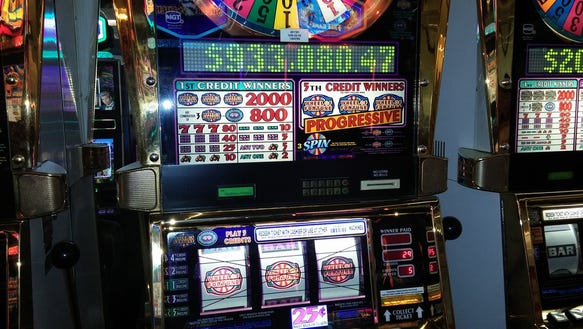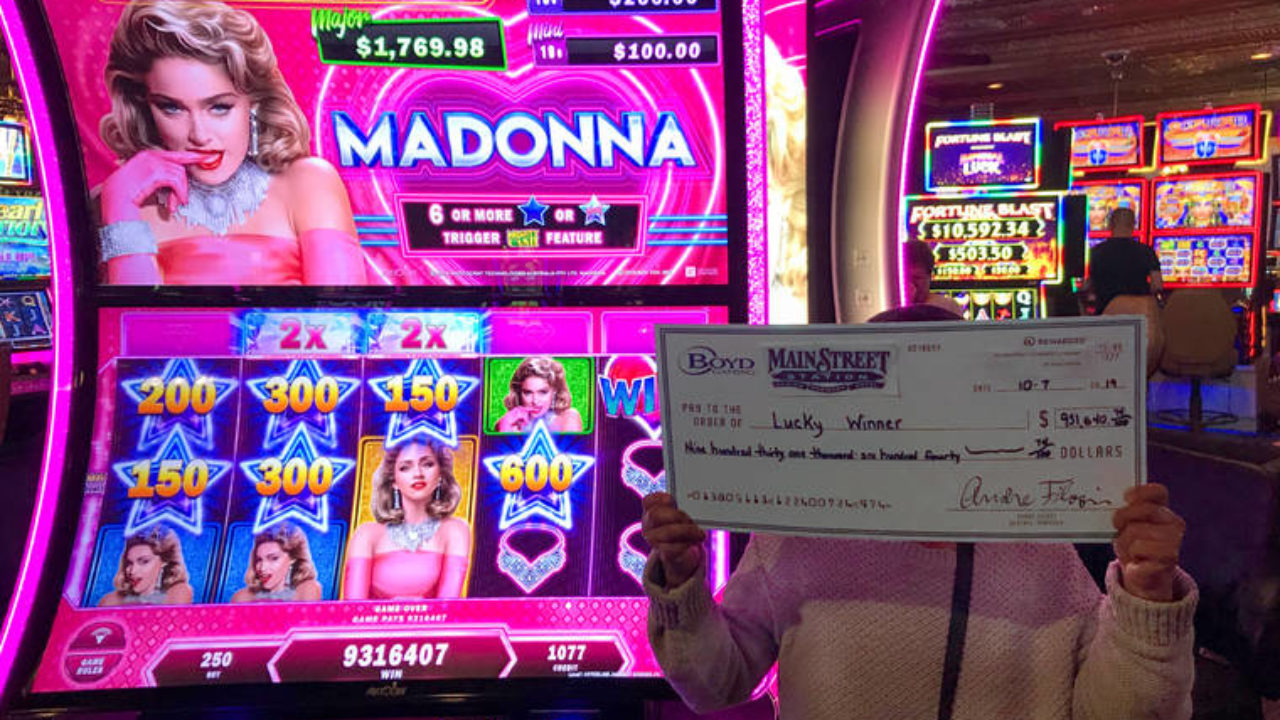Playing to Win Play the maximum number of coins. Many machines require that a player gamble. With denominations ranging from 1¢ to $1,000, we have thousands of slots, video poker and electronic table games. Slots - MGM Grand Las Vegas MGM Grand is pleased to welcome you back.
Slots today are much more sophisticated than they were in previous decades. The first reel-style slot machine, invented by Charles Fey in 1895, featured 3 individual reels with symbols like horseshoes and clovers. A jackpot was triggered when the player hit a Liberty Bell on each reel.
Fey’s machines were quite popular and were soon found in saloons across the San Francisco Bay Area. He originally split revenues with the bar owners, but after one of his machines was stolen, and similar machines hit the market, Fey switched to renting or selling his machines.
Slot manufacturers like Mills, Jennings, Pace, and Watling came and went over the next 60 years. During that time the machines were found in bars and roadhouses across the United States. Similar machines were also popular in Great Britain and Germany.
In the US, most states eventually outlawed open-gambling, but the slots were tolerated in many locations until the late 1930s when Nevada was the only remaining state with legalized gaming.
Although machine styles and designs changed, the overall operation and mechanics of the slots did not.
A single cherry symbol usually paid 2 coins, while 2 cherry symbols paid 5 coins. An orange on all 3 reels usually paid 10 coins, while plums or bells paid as high as 18 coins. A jackpot was 150 coins, meaning a nickel machine paid a total jackpot of $7.50.
The machine automatically dropped 20 coins, and the remaining $6.50 was paid by an attendant.
The monster machines drew crowds, but Bally had an even more important change that revolutionized slots. Previous machines had used metal tubes and slides to make payoffs that ranged from 2 to 20 coins.
Bally’s new Money Honey machines changed all that, with sleek designed fronts that opened on a hinge and gave slot attendants the ability to fill an electro-mechanical hopper with coins.
The new process allowed players to hit larger payouts and be paid automatically as the hopper spun and dispensed jackpots, counting the payout as it went.
Just 15 years later, the gaming industry introduced computer-run machines to their customers. The new machines used computer motherboards and removable chips to change game parameters. The machines used now employ random number generators to ensure safety and fair payouts for huge jackpots that have reached more than $20 million.
The machines most popular in the early days of Las Vegas had 3 reels and symbols like cherries, plums, oranges, and bells. A standard slot had 20 symbols per reel, so the odds of hitting the jackpot were 8000 to 1.
Today, machines can have nearly unlimited combinations. In fact, the largest group jackpot is offered by IGT on their Megabucks machines.
Those machines have virtual reels with 368 possible stops. Each virtual reel has one jackpot symbol. 368 x 368 x 368 gives the player one chance in 49,836,032 spins to hit the jackpot. Yes, the odds are high, but so are the jackpots, often over $20 million.
Unfortunately, nearly every large group (or linked machine) jackpot has a payoff made over 25 years. What that means is that if the jackpot is $1 million, you get a check for $40,000 the day you hit the big one. Then, you get a check in the mail for the same amount annually for 24 years.
Return to player (RTP) is very important in regard to the long-term chances of winning with slots. RTP (a.k.a. payback) refers to how much slot machines are programmed to pay out in the long run.
Higher payback means that a game gives you a stronger chance of winning. Therefore, you’ll do well to know the RTP behind any game that you play.
You’ll discover that it’s really easy to find payout percentages for online slot machine games. A simple Google search will produce the RTP for most internet games.
Unfortunately, you’ll have a much tougher time figuring out the RTP of land-based machines. In fact, this information is rarely available.
Is there still a way for you to determine payout percentages for slot machines in brick-and-mortar casinos? I’ll answer this question by covering more on the difficulties of finding RTP for land-based slots and if it’s ultimately possible.
Why Isn’t RTP Available for Land-Based Slots?
Unlike with many online slots, you can’t just find the RTP for land-based slot machines through Google. Your efforts will turn up little to no results.
How Many Slot Machines Are In The Las Vegas Airport
The problem with slots in brick-and-mortar casinos is that they don’t have uniform payback across every casino. Instead, game developers allow casinos to select payout percentages based on a list of options.
Here’s an example on how this works:
- WMS is offering Monopoly Party Train slot to Vegas casinos.
- They feature the following RTP options: 92.5%, 93.5%, and 94.5%.
- Caesars Palace orders this game at 93.5% payback.
- The Venetian orders Monopoly Party Train at 92.5% RTP.
- Treasure Island orders this slot at 94.5% RTP.
You can see the obvious challenge in trying to provide payback numbers for such games. A website could list Monopoly Party Train at 93.5% RTP, which is middle ground.
Most online slot providers differ because they offer their games at a uniform RTP across every casino. For example, Rival Gaming will feature Spy Game with 95.1% payback at each online casino it serves.
Some exceptions do exist in the online gambling world. RealTime Gaming (RTG), for instance, allows its casino clients to choose 91.5%, 95%, or 97.5% RTP for a given game.
You can’t find payout percentages for RTG games either. Nevertheless, you can still learn the payback for the vast majority of internet slots.
How Can You Figure out the RTP?
You won’t be able to find the exact payout percentages for most land-based slot machines. But you can at least get a good idea on the matter through a few different methods. Here are some ways to learn the RTP for brick-and-mortar casino slots.
Make General Guesses Based on Coin Denominations
Casinos like to reward gamblers who are willing to risk more money per bet. Therefore, they order higher RTP for games with larger coin denominations.
Here’s an example on how this works:
- Penny slot machines = 88% to 90% RTP
- Nickel slot machines = 91% to 94% RTP
- Quarter slot machines = 93% to 95% RTP
- Dollar slot machines = 94% to 96% RTP
- $5 slot machines = 95% to 97% RTP
Penny slot machines are almost always the worst games with regard to payout percentages. Larger denominations ranging from a nickel to $5 are all closer in terms of payback.
Your theoretical losses will be higher on nickel games and up just because you’re betting more per spin. Nevertheless, you can still get more value per dollar wagered with the higher-denomination machines.
Read State Gaming Reports
Rather than making generalizations about coin sizes, you can always check out state gaming reports. These reports show the average payout percentages (or house edges) for each coin denomination within a given state’s casinos.
For example, you might look at a Nevada Gaming Commission (NGC) release and see that dollar slot machines are offering 94.79% RTP on average.
How Many Slot Machines In Las Vegas
Interestingly enough, the NGC reports specific payout information for Megabucks. This IGT product is the most popular slot in all the popular Las Vegas casinos and warrants more detailed info.
You won’t find the exact payout percentage for an individual game, but you’ll at least have a better guideline with these reports.
Email a Casino and Ask
One more option involves emailing a casino directly and asking them about their RTP for a specific slot machine.
The problem here is that customer service will often state that they don’t have this information available. But in certain cases, you may actually receive a real answer.
You shouldn’t count on this method majority of the time. It’s at least worth trying, though, if you’re desperate to find out the RTP for certain slots.
What to Avoid When Searching for Land-Based Slots Payback

You can see that there are a few different options for determining the payback for land-based slot machines. But there are also measures that you want to avoid on your payback-finding quest, including the following.

Relying on Signs Inside of Casinos
Many casinos hang signs above a bank of slot machines that will read something like, “Pays up to 99%.”
These signs are very effective at drawing players to slot machines. After all, who wouldn’t want to play a slot that only has a 1% house edge?
Unfortunately, these signs are also very misleading. Only one of the machines within the section has to offer 99% RTP.
The rest could pay as low as 90% RTP and still make the sign valid. Therefore, you can’t rely on much information that the casino supplies you with.
Using One Good Session to Determine Quality Payback
Slots are extremely volatile games that may pay a lot one session, then offer very few prizes for the next five sessions. Therefore, you can never use any single outing to judge how a game pays.
Many gamblers still make this very mistake. They’ll have one hot session with a game and believe that it offers a high payout percentage.
It would be great if finding RTP for land-based slot machines was really this simple. The reality, though, is that it’s anything but.
Blindly Believing Ads for the “Loosest Slots”
I’ve seen plenty of ads for loose slot machines when driving on the interstate. These billboards suggest that a given casino features slots with high RTP or frequent payouts.
However, “loose” is a broad term that doesn’t really mean anything. State gaming laws don’t put parameters on what constitutes a loose game.
Casinos can make this claim, regardless of whether it’s true or not. That said, you should take any such advertisement with a grain of salt.
Conclusion
You may think negatively about land-based casinos upon being unable to find RTP for their slots. After all, you don’t have to spend much time at all finding payback for online slots.
However, providers are the ones who choose whether to or not to release payout percentages. They can’t accurately do this with slot machines at brick and mortar casinos, because providers feature different RTP options.
One casino may order a slot at 93% payback, while the next orders it at 95% RTP. Developers are therefore unable to offer a uniform payout percentage for each slot.
The good news, though, is that you don’t have to give up hope. Instead, you have a few options for finding general RTP figures.
The easiest method is to make generalizations based on coin denominations. Simply put, the higher coin denominations usually offer better payback.
You can also read state gaming reports. These releases show the average amount that each coin denomination pays out within a given state’s gambling venues.
Finally, you can always email a casino directly and ask about a specific game. You won’t get the desired answer most of the time, but it’s worth trying.
In summary, finding the RTP for an individual land-based slot is impossible in most cases. But you’ll still have a general idea on how much these slots pay by following the previously covered tips.